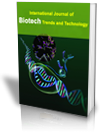Eradication of Ovarian Cancer Stem Cells in Ovarian Cancer Using Stem Cell Therapy
Citation
MLA Style:Nirav Parmar, Vinod Kumar Gupta "Eradication of Ovarian Cancer Stem Cells in Ovarian Cancer Using Stem Cell Therapy" International Journal of Biotech Trends and Technology 11.2 (2021): 15-24.
APA Style:Nirav Parmar, Vinod Kumar Gupta 2021). Eradication of Ovarian Cancer Stem Cells in Ovarian Cancer Using Stem Cell Therapy. International Journal of Biotech Trends and Technology, 11(2), 15-24.
Abstract
One of the most frequent gynaecological malignancies in the world and one of the main causes of cancer-based female death is ovarian cancer. About 3 out of 4 (72.4 percent) women with OC survive for at least one year following diagnosis for all forms of ovarian cancer. Five years after diagnosis, almost half (46.2 per cent) of women with OC are still living. Ovarian epithelial malignancies are mostly imported from the endometrial or fallopian tube epithelium. Ovarian cancer therapy is difficult because of a frequent recurrence of diseases and further difficult owing to chemical resistance. Cancer stem cells (CSCs) continue to get interest since they are known to withstand chemical treatment, to renovate themselves, and to re-populate the bulk cell tumour. CSCs also seem to respond quickly to environmental, immunological and pharmacological indications. The flexibility and capacity to inactivate or activate signaling pathways that support their lifespan has been and remains the difficulty in creating effective CSC-targeted treatments. The identification and comprehension of distinct ovarian CSC markers and the pathways may provide novel therapeutic possibilities that provide different therapy adjuvant choices. Here we will examine the characterization of ovarian CSC in OC and stem, isolation and enhancement of CSC and OCSCs signals and targeted therapies.
References
[1] M. Ohkuma, S. Noda, and T. Kudo., Phylogenetic Diversity of Nitrogen Fixation Genes in the Symbiotic Microbial Community in the Gut of Diverse Termites, Appl. Environ. Microbiol., 65(11) (1999) 4926–4934.
[2] Peristiwati, Y. S. Natamihardja, and H. Herlini., Isolation and identification of cellulolytic bacteria from termites gut ( Cryptotermes sp .), J. Phys. Conf. Ser., 1013 (2018) 012173.
[3] S. Moriya, K. Tanaka, M. Ohkuma, S. Sugano, and T. Kudo., Diversification of the Microtubule System in the Early Stage of Eukaryote Evolution: Elongation Factor 1? and ?-Tubulin Protein Phylogeny of Termite Symbiotic Oxymonad and Hypermastigote Protists,” J. Mol. Evol., 52(1) (2001) 6–16.
[4] G. Tokuda and H. Watanabe., Hidden cellulases in termites: revision of an old hypothesis, Biol. Lett., 3(3) (2007) 336–339.
[5] A. Ferbiyanto, I. Rusmana, and R. Raffiudin., Characterization and Identification of Cellulolytic Bacteria from gut of Worker Macrotermes gilvus, HAYATI J. Biosci., 22(4) (2015) 197–200.
[6] Z. Barta, K. Kovacs, K. Reczey, and G. Zacchi., Process Design and Economics of On-Site Cellulase Production on Various Carbon Sources in a Softwood-Based Ethanol Plant, Enzyme Res., 2010 (2010) 1–8.
[7] C.-M. Wang, C.-L. Shyu, S.-P. Ho, and S. Chiou., Characterization of a novel thermophilic, cellulose-degrading bacterium Paenibacillus sp. strain B39, Lett. Appl. Microbiol., 47(1) (2008) 46–53.
[8] S. Chovatiya, S. Ingle, D. Patel, and B. Thakkar., Isolation of Bacteria Producing Cellulase from Tilapia Fish Gut and Media Optimization for Celluase Production using Plackett Burman Design, Int. J. Biotech Trends Technol. ( IJBTT ), 7(2) (2017)13–19.
[9] T. K. Ghose., Measurement of Cellulase Activities, Pure Appl. Chem., 59(2) (1987) 257–268.
[10] S. Sharma et al., Isolation and Characterization of Cellulose Degrading Bacteria of Termite Gut from North Eastern Region of India Special Issue on : Recent Advances in Isolation and Characterization of Cellulose Degrading Bacteria of Termite Gut from North Eastern Region, South Asian J. Exp. Biol., 5(6) (2015) 283–290.
[11] M. Wenzel, M. Berchtold, P. Kampfer, and H. Konig., Aerobic and facultatively anaerobic cellulolytic bacteria from the gut of the termite Zootermopsis angusticollis, J. Appl. Microbiol., 92 (2002) 32–40.
[12] M. Maki, K. T. Leung, and W. Qin., The prospects of cellulase-producing bacteria for the bioconversion of lignocellulosic biomass, Int. J. Biol. Sci., 5(5) (2009) 500–516.
[13] G. M. Bohlmann., Process economic considerations for production of ethanol from biomass feedstocks, Ind. Biotechnol., 2(1) (2006) 14–20.
[14] A. Kazemi, S. Rasoul-Amini, M. Shahbazi, A. Safari, and Y. Ghasemi*, Isolation, Identification, And Media Optimization Of High-Level Cellulase Production By Bacillus Sp. Bccs A3, In A Fermentation System Using Response Surface Methodology, Prep. Biochem. Biotechnol., 44(2) (2014) 107–118.
[15] T. Sartori, H. Tibolla, E. Prigol, L. M. Colla, J. A. V. Costa, and T. E. Bertolin., Enzymatic Saccharification of Lignocellulosic Residues by Cellulases Obtained from Solid State Fermentation Using Trichoderma viride, Biomed Res. Int., (2015) 1–9.
[16] N. Annamalai, M. V. Rajeswari, and T. Balasubramanian., Enzymatic saccharification of pretreated rice straw by cellulase produced from Bacillus carboniphilus CAS 3 utilizing lignocellulosic wastes through statistical optimization, Biomass and Bioenergy, 68 (2014) 151–160.
[17] A. G. Marangoni., Enzyme Kinetics: A Modern Approach. , John Wiley & Sons, New York, NY, USA., (2003).
[18] D. Schell., A bioethanol process development unit: initial operating experiences and results with a corn fiber feedstock, Bioresour. Technol., 91(2) (2004) 179–188.
[19] M. Camassola and A. J.P. Dillon., Cellulase Determination: Modifications to Make the Filter Paper Assay Easy, Fast, Practical and Efficient, J. Anal. Bioanal. Tech., 1(S1) (2012) 1–5.
Keywords
Ovarian cancer, Cancer stem cell, chemotherapy, CSC marker, Stemness, pharmacologic.


